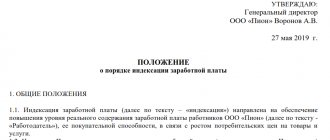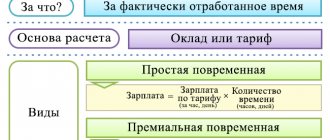The economic crisis has a negative impact on the well-being of the population. Wage indexation in 2022 will make it possible to at least slightly increase the real level of income of people working in the public sector. We are talking about municipal and government employees, whose managers, in accordance with the Labor Code of the Russian Federation, are required to carry out indexation. But is it necessary to index wages in 2020 in commercial organizations? Or should only budgetary organizations increase wages? Is indexation a right or an obligation of an employer? What is the latest news on this indexation for public sector employees? Let's figure it out.
Delicate duty of the employer
The Labor Code contains norms that define possible and mandatory ways to improve people's living standards. Indexation of the minimum wage is one way. If an employee works in a company that is not financed by the state budget, then it is still necessary to carry out indexation, but on the basis of the following documents:
- internal company rules;
- collective agreement;
- agreements.
Remember that ensuring indexation is the direct responsibility of the employer! Moreover, it should immediately affect all employees of the enterprise. Regulatory provisions on wage indexation provide for its mandatory implementation in organizations not only of the budgetary, but also of the extra-budgetary sphere. The difference lies only in some procedural points.
Private firms and individual entrepreneurs themselves determine how to carry out indexation. This gives business owners the opportunity to take into account the interests of not only their subordinates, but also their own benefits.
Indexation of the staffing table and employee earnings “in the old way”
By default, documents that can be used to index the staffing table and wages in 1C 8.3 ZUP “in the old way” are hidden from the interface - this is the Indexation of the staffing table (Personnel - Indexation of the staffing table) and Indexation of earnings (Salary - Indexation of earnings).
In order for the document Indexation of the staffing table :
- In chapter Personnel Click the gear-shaped button located in the upper right corner to select Setting up navigation:
- In the form that opens, in the left table, find the document Indexation of the staffing table and add it to the right table (by double-clicking or using the buttons located between the tables):
After this, the document Indexation of the staffing table can be created from the Personnel :
To display the Indexation of Earnings in the Salary using the “gear” button located in the upper right corner, also select Navigation Settings .
In the form that opens, in the left table, find the document Indexation of earnings and add it to the interface in the same way as the document Indexation of staffing :
The document Indexation of earnings will become available in the Salary :
The limitation of these documents is that, unlike the documents Changing the staffing table and Changing planned accruals, they can index only a limited number of indicators: Salary , Tariff rates (daily, hourly). However, they also have an advantage over indexing documents “in a new way” - they can configure rounding:
In order to index the staffing table and earnings in 1C 8.3 ZUP, fill out the Indexation coefficient :
Since October 1, the organization has been indexing salaries and tariff rates by 10%.
In order for staff indexation to be registered from October 1, 2019, indicate October 2022 the Month
The date of the document does not affect indexing.
In the Indexed indicators , configure the rounding of indicator values:
In the Indexation coefficient , enter the value – 1.10 (indexation by 10%):
Indexation of the staffing table will be completed.
Based on the document Indexation of the staffing table, create a document Indexation of earnings :
In the Earnings Indexation , calculation and filling will be done automatically:
We have successfully discussed how to do salary indexation step by step, how to change the indexation coefficient in 1C 8.3 ZUP.
For whom is it required?
Many employers deliberately avoid mentioning indexing in their internal documents. They believe that the lack of information about indexation in 2022 is not a violation. Meanwhile, the organization must at least index the minimum wage. Even though there is no legally established procedure for its implementation today. Also see “Minimum wage in 2022 in Russia”.
If they ignore the need for indexation, employers may face unpleasant consequences if labor inspectors come. By the way, further decisions of controllers may be different:
- will be required to enter information about the procedure for indexing wages at the enterprise into a current internal document or to adopt a new act on this in the organization;
- the responsible persons will be held administratively liable in the form of a fine (Article 5.27 of the Code of Administrative Offenses of the Russian Federation).
Note that the second point is controversial. And in case of disagreement with the fine, the employer can go to court. Current judicial practice shows that decisions in such a case can be made both in favor of the employer who applied and in favor of the inspectors.
If an organization has a provision on wage indexation, but the employer does not comply with it, then during an inspection the company may most likely be fined.
As noted by the Constitutional Court of the Russian Federation in Determination No. 2618-O dated November 19, 2015, the wages of all persons working under an employment contract must be indexed.
Employers - state bodies, local government bodies, state and municipal institutions index wages in the manner prescribed by labor legislation and other regulatory legal acts containing labor law norms (Article 134 of the Labor Code of the Russian Federation).
Employers not related to the public sector also do not have the right to deprive their employees of the guarantee provided by law and evade the establishment of indexation (Determination of the Constitutional Court of the Russian Federation dated November 19, 2015 N 2618-O). Such employers index wages in accordance with the procedure established in the collective agreement, agreements, and local regulations (Article 134 of the Labor Code of the Russian Federation).
How to index your salary
The law does not define the indexation procedure, so the employer chooses it independently and fixes it in local regulations and the collective agreement (Article 134 of the Labor Code of the Russian Federation). The Ministry of Labor allows the use of an indexation coefficient and increase wages without it (letter of the Ministry of Labor dated December 24, 2018 No. 14-1/OOG-10305).
For more information about indexation methods, read the article: “How to correctly index salaries in 2022: instructions for an accountant.”
In 2022, the Prosecutor General’s Office may enter the game
You may receive a fine for not indexing your employees' salaries. This is the responsibility of every company (Article 134 of the Labor Code). The prosecutor’s office will now check whether the company indexes employees’ salaries (Order of the Prosecutor General’s Office dated March 15, 2020 No. 196). Previously, only labor inspectors were involved in this, but they are not able to control all companies - there are not enough people. To begin an investigation, prosecutors only need an employee’s statement that his salary is not being increased. If this information is confirmed, prosecutors will forward the information to labor inspectors. They will fine the company up to 50,000 rubles. (Part 1 of Article 5.27 of the Administrative Code). The draft order of the Prosecutor General is already undergoing anti-corruption examination. Therefore, it is worth specifying the indexing order now, if you have not already done so.
The procedure for salary indexation
Wage indexation is discussed in Article 134 of the Labor Code of the Russian Federation. However, there is no clear and understandable procedure for wage indexation. Therefore, in commercial organizations, wage indexation is carried out, including in 2022, according to the rules of the collective agreement or from local regulations.
When drawing up a document on the basis of which you will index salaries, you must remember that it must contain the following information:
- The nature of payments subject to indexation.
This usually concerns salaries or tariff rates at the enterprise. Moreover, the employer can index not the entire amount of the salary, but some part of it, limited to a certain amount. For example: the salary is 30,000 rubles, and only 14,000 rubles from it are indexed. The remaining 16,000 rubles are not subject to indexation.
- Indexation period.
The employer can choose the frequency at his discretion (once a month, six months, a year).
- The procedure for determining the wage indexation coefficient.
- The sequence of calculating wages after indexation.
Keep in mind: the absence of any of these points implies a violation of labor laws and entails consequences. This means that simply drawing up an internal document is not enough. It also needs to comply with existing standards. To avoid possible mistakes, it is better to carefully study any example of wage indexation.
If we talk about reality, then in the collective agreement the clause on annual wage indexation is most often included by large companies that have joined industry agreements with such an obligation. For example, such a norm is in the Federal Industry Agreement on Communications and Information Technologies Organizations of the Russian Federation for 2015–2022. The Ministry of Labor invited companies to join it by letter dated May 5, 2015 No. 14-4/10/B-3127.
If we talk about small organizations, a collective agreement is not always concluded. But even if such an agreement has been drawn up, it often either does not contain a clause on salary indexation.
Another option is to provide for a condition on indexation in the Regulations on remuneration.
Indexation of staffing
Index the staffing table in 1C ZUP 3.1 using the document Change of staffing table (Salary - Change of staffing table).
Indexing the staffing table using this document is intended only if the program maintains a history of changes to the staffing table (Settings - Personnel records - Setting up the staffing table - Maintains a history of changes to the staffing table).
If the staffing table is maintained without saving history, then to change salaries in the staffing table, you should go to each position of the staffing table and set new salary sizes.
In the document Change of staffing :
- Indicate the date of change - the date from which the change (indexation) of the staffing table will be registered;
- Select employees - during indexing, positions change, so you need to use the Change position and select positions for indexing in the selection window;
- After filling the tabular part of the document with positions, perform indexing using the Fill in indicators . In the window that opens, select the indicators that you want to index. Next, if you need to reflect the indexation of this indicator, specify the filling type for them: Multiply by and determine the indexation indicator.
After this, for all positions selected in the document, the size of the selected indicators will change:
Thus, you can index (change) any available indicators in the document.
By default, the document displays only those indicators that are included in the aggregate tariff rate (Settings - Salary calculation - Indicators that determine the composition of the aggregate tariff rate). However, other indicators can be displayed in the document. To do this, use the command in the tabular part of the document More – Displayed indicators and select indicators.
Criteria for revising earnings in 2020
Wage indexation is a necessary procedure due to rising consumer prices. Rosstat monthly calculates consumer price indices and inflation rates for each region and all of Russia. Based on this data, employers most often make wage indexation calculations. Also see “Minimum wages today.”
The link to the price index must be made in the internal act of the organization. At the same time, wage indexation can be carried out based on changes for one month or for several at once. To get your bearings, you can view the values of consumer price indices on the official Rossat website for 2022.
Wage indexation is a way to protect earnings from inflation due to rising consumer prices.
The amount of wage indexation in 2022 may correspond to:
- the official consumer price index for the country or in a particular region (based on the results of a certain period, for example a quarter, half a year, year);
- the amount of inflation established in the annual federal law or the law of the region in which the organization operates;
- growth of the living wage of the working population.
When calculating the indexation coefficient, the main indicator is not a mandatory value. How to index salaries - taking into account inflation or depending on other conditions - is decided by management. For example, with a forecast inflation of 6%, employee salaries can be indexed by 4 or 7%. The employer may choose another arbitrary value, unless a different procedure is determined by the labor or collective agreement. Accordingly, salary indexation in 2022 will be carried out by this amount. Here's what a sample for wage indexation in 2022 in a commercial organization might look like:
Increase in salary depending on the minimum wage
Since 2022, in terms of establishing the value of the federal minimum wage for the next year, the rule has come into effect regarding its compliance with the subsistence minimum of the population capable of working for the second quarter of the previous year (Article 3 of the Law “On Amendments...” dated December 28, 2017 No. 421-FZ ). And from 2022, the minimum wage was decoupled from the subsistence minimum and equated to the median wage calculated by statistical authorities.
In order to achieve this compliance, from May 2022 the federal minimum wage was increased to 11,163 rubles. In 2022, the minimum wage was 11,280 rubles, and from 01/01/2020 the minimum wage is 12,130 rubles. From 01/01/2021 the minimum wage is 12,792 rubles.
Read about the dynamics of the minimum wage in 2013 - 2022 here.
The increase in the federal minimum wage in 2022 leads to an indexation of the salaries of those individuals whose earnings are determined by the value of this indicator, as well as to an increase in the size of the minimum wage applied in the regions. The regional minimum wage cannot be lower than the federal one (Article 133.1 of the Labor Code of the Russian Federation), and it is for this reason that in many regions of the Russian Federation there is an indicator established at the federal level.
You will find the minimum wage for any region of Russia in ConsultantPlus. Get trial access to the system for free and go to the Directory.
Is indexation mandatory in a commercial organization in 2022?
Is it necessary to index wages in a commercial company? Article 134 of the Labor Code of the Russian Federation says in this regard that one of the main state guarantees for remuneration of workers is to ensure an increase in the level of real wages. This includes indexation of wages in connection with rising consumer prices for goods and services, that is, taking into account inflation.
At the same time, the condition for wage indexation applies to all persons who work under an employment contract (ruling of the Constitutional Court dated November 19, 2015 No. 2618-O). The judges noted that salary indexation applies to both public sector employees and employees of commercial companies. It turns out that the management of commercial structures must also take care of wage indexation in 2022.
How is vacation pay indexed?
The indexation of vacation pay depends on the following factors:
- If the salary increase occurred during the period that is used to calculate vacation pay, then the SZ must be adjusted to the CI for the entire billing period.
- If the increase occurred during a period that is not included in the calculation of vacation pay, but precedes the vacation, then the SZ must be indexed for the calculation period.
- In cases where the salary increase occurred on vacation days, the SZ is adjusted from the date of the salary increase.
To index vacation pay, you must use the CI calculated using the above formula.
Note that the calculation period for determining the SZ for vacation pay is 12 months preceding the start date of the vacation.
For more information about the nuances of calculating vacation pay, see the article “What is the calculation period for vacation - vacation experience .
Indexation of wages in budgetary organizations in 2022
Will public sector employees be entitled to indexation in 2022? In this regard, it is worth saying that on January 1, 2022, the suspension of wage indexation for public sector employees in Russia expires. We are talking about the salaries of state civil servants, military personnel, judges and other persons who are in the public service (Article 1, 4.3 of the Law of April 6, 2015 No. 68-FZ).
The Ministry of Labor proposes to index the monthly salaries of federal civil servants by 1.043 times from October 1. They plan to increase the salaries of employees of the Ministry of Foreign Affairs, diplomatic missions and consular offices of the Russian Federation in accordance with the positions being filled and the diplomatic ranks assigned to them, and the salaries of federal civil servants - in accordance with the positions being filled and the grade ranks of the civil service. The salaries of civil servants will also be increased in accordance with the class ranks of justice assigned to them.
They want to increase the salaries of those employees of federal government agencies who are not civil servants by the same amount. The last increase in salaries for officials occurred in January 2022. Then the increase was 4%.
Indexation of earnings
Input based on the document “Change in staffing”
To register the indexation of employee earnings in 1C 8.3 ZUP, use the document Change of planned accruals (Salary - Change of employee pay - Change of planned accruals). This document can be entered based on the document Change of staffing table - command Change employee accruals .
In the document Change of planned accruals, the Consider as indexation of earnings checkbox is automatically selected and all indicators for employees are filled in already indexed, based on the changes made in the corresponding positions in the document Change of staffing table .
Let's look at an example of how the indexation coefficient is calculated in 1C 8.3 ZUP in the document Change of planned accruals .
The document Changing the staffing table reflected the fact that the salaries of all positions were increased by multiplying by a factor of 1.1, as well as an increase in the percentage of calculation of the monthly bonus from 10% to 12%.
In particular, there was a change in the salary of the position Gas Meter/Production Department .
Next, based on the Change in the staffing table, Change in planned accruals is entered . The document is filled out automatically and the indexation coefficient is calculated for each employee.
The position of Gas Meter/Production Department is occupied by employee Gerankin G.G. The employee's salary increased from 20,000 to 22,000 (1.1 times), and the bonus percentage changed from 10 to 12. The indexation coefficient in the document is calculated as follows:
- Indexation coefficient = New payroll / Old payroll = (22,000 + 22,000 *12%) / (20,000 + 20,000*10%) = 24,640 / 22,000 = 1,12
Manual entry of the document “Change of planned accruals” to register indexation
If the change in the staffing table was not reflected or the history of changes in the staffing table is not maintained, then create the document Change of planned accruals from the document journal Change of employee pay (section Salary ).
From January 1, employees of the organization undergo indexation of earnings:
- The salary increases by a factor of 1.05;
- Monthly premium percentage from 10% to 15%.
In the document Changing planned accruals to register such indexation, fill out the document with the necessary employees, check the Consider as indexation of earnings and reflect the change in accruals using the Fill in indicators :
After this, the salary and bonus will change, as well as the calculation of the indexation coefficient. The calculation of the indexation coefficient will be performed as follows (using the example of employee Jasmine Z.K.):
- Indexation coefficient = New payroll / Old payroll = (47,250 + 47,250 *15%) / (45,000 + 45,000*10%) = 54,337.5 / 49,500 = 1,09772727







